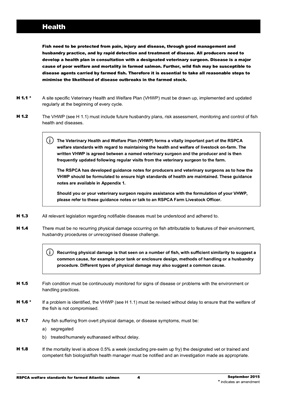
RSPCA welfare standards for farmed Atlantic salmon 4 September 2015
* indicates an amendment
Health
Fish need to be protected from pain, injury and disease, through good management and
husbandry practice, and by rapid detection and treatment of disease. All producers need to
develop a health plan in consultation with a designated veterinary surgeon. Disease is a major
cause of poor welfare and mortality in farmed salmon. Further, wild fish may be susceptible to
disease agents carried by farmed fish. Therefore it is essential to take all reasonable steps to
minimise the likelihood of disease outbreaks in the farmed stock.
H 1.1 * A site specific Veterinary Health and Welfare Plan (VHWP) must be drawn up, implemented and updated
regularly at the beginning of every cycle.
H 1.2 The VHWP (see H 1.1) must include future husbandry plans, risk assessment, monitoring and control of fish
health and diseases.
The Veterinary Health and Welfare Plan (VHWP) forms a vitally important part of the RSPCA
welfare standards with regard to maintaining the health and welfare of livestock on-farm. The
written VHWP is agreed between a named veterinary surgeon and the producer and is then
frequently updated following regular visits from the veterinary surgeon to the farm.
The RSPCA has developed guidance notes for producers and veterinary surgeons as to how the
VHWP should be formulated to ensure high standards of health are maintained. These guidance
notes are available in Appendix 1.
Should you or your veterinary surgeon require assistance with the formulation of your VHWP,
please refer to these guidance notes or talk to an RSPCA Farm Livestock Officer.
H 1.3 All relevant legislation regarding notifiable diseases must be understood and adhered to.
H 1.4 There must be no recurring physical damage occurring on fish attributable to features of their environment,
husbandry procedures or unrecognised disease challenge.
Recurring physical damage is that seen on a number of fish, with sufficient similarity to suggest a
common cause, for example poor tank or enclosure design, methods of handling or a husbandry
procedure. Different types of physical damage may also suggest a common cause.
H 1.5 Fish condition must be continuously monitored for signs of disease or problems with the environment or
handling practices.
H 1.6 * If a problem is identified, the VHWP (see H 1.1) must be revised without delay to ensure that the welfare of
the fish is not compromised.
H 1.7 Any fish suffering from overt physical damage, or disease symptoms, must be:
a) segregated
b) treated/humanely euthanased without delay.
H 1.8 If the mortality level is above 0.5% a week (excluding pre-swim up fry) the designated vet or trained and
competent fish biologist/fish health manager must be notified and an investigation made as appropriate.
i
i